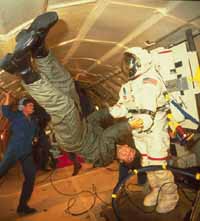
| ||
 | ||
| Getting sick in space |  Astronaut and McGill graduate Robert Thirsk, floating weightless aboard a NASA aircraft, studied motion sickness while in space. McGill physiologist Doug Watt may have found a solution. |
|
DANIEL McCABE | Astronauts everywhere may owe Doug Watt a debt of thanks. A McGill physiology professor and one of Canada's top space scientists, Watt thinks he knows part of the reason so many astronauts become "space-sick" when they go into orbit.
About half of all astronauts who go into space develop a bad case of motion sickness that can last several days. According to Canadian astronaut and McGill graduate Robert Thirsk, the condition leaves astronauts feeling like a total wreck on their star trek. "The blood rushes out of your head and you'd rather crawl into a corner and be left alone. There's cold sweating, nausea, vomiting," declared Thirsk at a recent conference on the Columbia space shuttle's 1996 mission. Thirsk worked aboard Columbia during its 17-day mission and was one of four astronauts who participated in an experiment designed by Watt for the shuttle's crew. "It's not very pleasant for the astronauts and it could be dangerous if somebody became incapacitated in an emergency situation," explains Watt. "If a crew isn't very efficient for a few days because they're feeling sick, it can also put them behind schedule." With millions of dollars invested in every space mission, that means that "big bucks" are wasted, Watt adds. According to Watt, there are two components to motion sickness. The first involves general susceptibility Watt had an inkling that astronauts in space were doing something that was the cosmic equivalent of reading in a car and that many of them were suffering from especially bad cases of motion sickness as a result. With that in mind, Watt and his research team devised the Torso Rotation Experiment for the Columbia mission. Astronauts aboard the Columbia wore special motion-monitoring headgear so that Watt could determine whether the astronauts moved their heads and torsos in unison or independently (Thirsk says the Columbia crew dubbed the apparatus the mission's "goofiest-looking experiment"). Past studies showed that astronauts often unconsciously begin to move their heads and bodies together while they adjust to a zero-gravity environment Watt suspected this was exactly the wrong thing to do and the data he collected from the Columbia mission seems to prove his hypothesis. "This movement turns off the body's normal navigational system for long periods "I think from now on, you won't see astronauts giving out that advice. We'll be telling people not to do that." Watt will also work on pre-adaptation programs to train astronauts to avoid the sorts of actions in space that could make a case of motion sickness more acute. "This will help astronauts, but it's not a cure," he says. Watt's next set of outer space experiments will take place aboard a space shuttle or |
|
| |||||